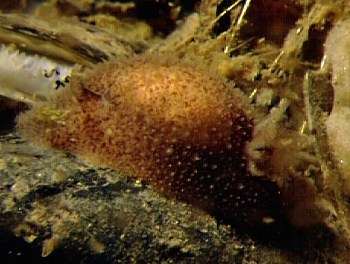
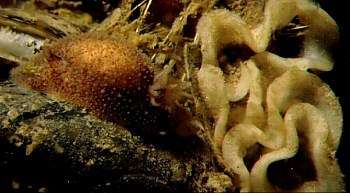
Acanthodoris pilosa
(Abildgaard in Muller, 1789)
Order: NUDIBRANCHIA
Suborder: DORIDINA
Superfamily: ANADORIDOIDEA
Subfamily: Onchidorididae
DISTRIBUTION
North Atlantic on both European and American coasts. Also recorded from North Pacific (Aleutian Islands to Morro Bay, California).
PHOTO
Zierikzee (Zeelandbrug), de Oosterschelde, the Netherlands. PHOTO: Peter H. van Bragt.
Usually reaches about to 40mm in length but can grow to 50mm. Intertidal and sublittoral species which feeds on encrusting bryozoans.
Reference:
• Abildgaard, Petrus Christianus. 1789. [In]: O. F. Muller. Zoologia Danica, etc., Vol. 39(3): 1-71, pls. 81-120.
• Muller, O. F. 1788. Zoologia Danica sev animalium Daniae et Norvegiae rariorum ac minus notorum descriptiones et historia, Vol. 2: 124 pp., pls. 51-80.
• Muller, O. F. (1789). Zoologica Danica sev animalium Daniae et Norvegiae rariorum ac minus rotorum descriptiones et historia, ed. 3, vol. 3: 1-71, pls 81-120.
Rudman, W.B., 1999 (August 22) Acanthodoris pilosa (Abildgaard in Muller, 1789). [In] Sea Slug Forum. Australian Museum, Sydney. Available from http://www.seaslugforum.net/find/acanpilo
Related messages
Acanthodoris pilosa from Puget Sound
March 17, 2008
From: Richard L. Zade
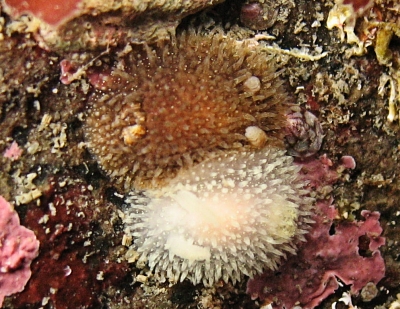
I found this mating pair and I am confused as to the ID of these guys. Separately I would name as two different speacies but together, I am not sure.
Locality: Port Townsend , 45 ft, WA, USA, Puget Sound, 16 November 2007, Rock Jetty. Length: 1 cm. Photographer: Richard Zade.
Richard Zade
rzade@hotmail.com
Zade, R.L., 2008 (Mar 17) Acanthodoris pilosa from Puget Sound. [Message in] Sea Slug Forum. Australian Museum, Sydney. Available from http://www.seaslugforum.net/find/21183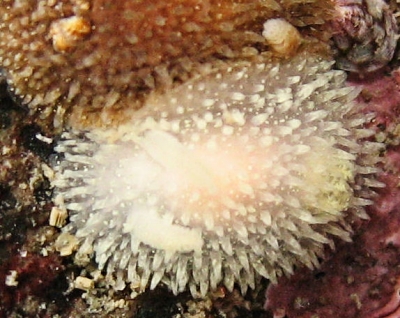
Hi Rich,
Members of the family Onchidorididae can be variable in coloration, with several species seeming to form a color gradation. My guess is this pair is Acanthodoris pilosa as I do not see a yellow margin, and no red on the tips of the rhinophores or gills. The dark colored individual is new to me. Very interesting.
Thanks,
Dave Behrens
Re: Acanthodoris pilosa from British Columbia
November 6, 2007
From: J. Hildering & G. Miller
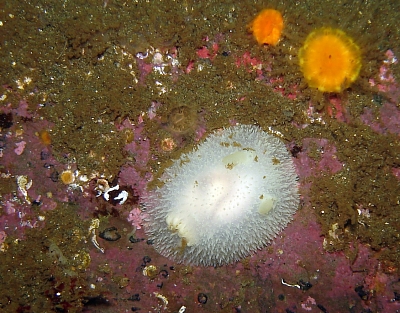
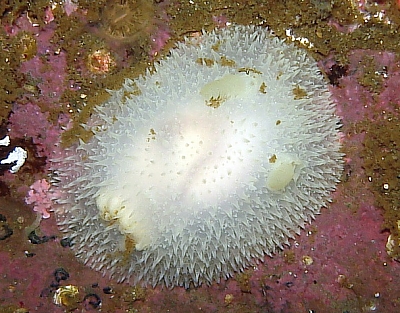
Concerning message #6891:
This is a new one for me as we don't commonly see Acanthodoris pilosa near the northern tip of Vancouver Island. Please could you let me know if I indeed have the ID correct? I thought too that the photo may be of interest as the digestive tract seems quite visible.
Locality: Bear Cove, 70 feet, British Columbia, Canada, Pacific Ocean, 08 October 2007, Silt bottom. Length: 5 cm. Photographer: Jackie Hildering.
Jackie Hildering & Glen Miller
earthlingenterprises@telus.net
Hildering, J. & Miller, G., 2007 (Nov 6) Re: Acanthodoris pilosa from British Columbia. [Message in] Sea Slug Forum. Australian Museum, Sydney. Available from http://www.seaslugforum.net/find/20922
Hi Jackie and Glen,
Very nice find. Definitely uncommon. Our fellow Branchers in the Atlantic trip across it more often than we here.
Those long tapering, pointed dorsal papillae are a give away.
Best wishes,
Dave Behrens
Re: Adalaria? Akiodoris? from Denmark
June 25, 2007
From: Sven Gust
Concerning message #20054:
Thanks Alexander and Bill!
I dont think that the specimen on the photos were disturbed but there was very hard current when I took the photos. I think you are right and it is most likely Acanthodoris pilosa. That is what I found out myself since I sent the question to Bill some weeks ago ;-).
Best regards
Sven
sven@tauchprojekt.de
Gust, S.O., 2007 (Jun 25) Re: Adalaria? Akiodoris? from Denmark. [Message in] Sea Slug Forum. Australian Museum, Sydney. Available from http://www.seaslugforum.net/find/20062Re: Adalaria? Akiodoris? from Denmark
June 21, 2007
From: Alexander Martynov
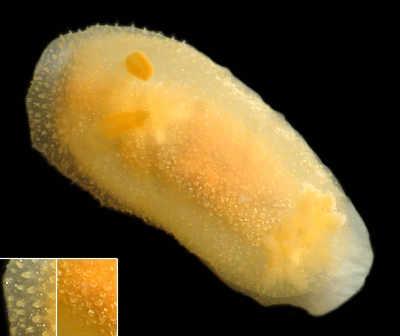
Concerning message #19430:
Dear Sven & Bill,
Both species of the genus Akiodoris are restricted only to the Northern Pacific and it is not likely that this genus may appear in the Northern Atlantic. Further, according to general shape of the notum and tubercle morphology these specimens are not Akiodoris or Adalaria.
The specimens are rather flattened and seemingly quite tightly adpressed to the substrata. Despite this, and judging from the considerably contracted rhinophores and gills, I guess that this shaped body is not very natural. Is it possible that the molluscs were somewhat disturbed before photographing? In this case I am rather inclined that the specimens are probably the common North Atlantic species Acanthodoris pilosa. In the animal in the upper photo ther are clearly conical tubercles at the edge of notum, typical for Acanthodoris pilosa. In their normal living condition, A. pilosa has a quite elevated, somewhat ovoid body and large multipinnate gills. Maybe these specimens were rather old since they were observed in winter, whereas (at least on the White and Barents Seas) adult specimens are usually found in summer. Returning to flattened body shape, some species of the genus Onchidoris, e.g. O. depressa and O. pusilla have a flattened body like this in life, but they have different colour of notum and gill morphology. Enlarged gills of one of these specimens suggests they are the contracted multipinnate gills of Acanthodoris rather than unipinnate ones of the Onchidoris. I attached two photographs of Acanthodoris pilosa: the first is rather similar to Sven's specimens, whereas the second represents the more typical shape of Acanthodoris pilosa.
Locality: Barents Sea, Dalne-Zelenetskaya Bay, intertidal, 01 August 2005, size 10-15 mm, photos by Tanya Korshunova.
Kind regards,
Alexander
sasha_martynov@inbox.ru
Martynov, A., 2007 (Jun 21) Re: Adalaria? Akiodoris? from Denmark. [Message in] Sea Slug Forum. Australian Museum, Sydney. Available from http://www.seaslugforum.net/find/20054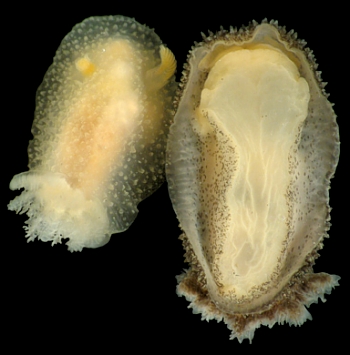
Thanks Alexander,
I mentioned Adalaria sp. A and Akiodoris because in drawings they both have the rings of spicules so visible in Sven's photos - not a very 'scientific approach - so I am very glad to have your considered opinion based on personal experience of these animals.
Best wishes,
Bill Rudman
Adalaria? Akiodoris? from Denmark
June 20, 2007
From: Sven Gust
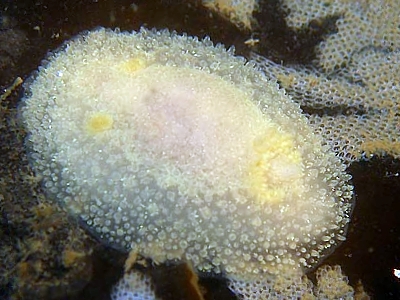

Hi,
I am not sure about the species:
It was observed in the Baltic at a site with heavy current in winter.
Locality: Lille Belt, 2-10 metres, Denmark, Baltic Sea, Jan./Feb. 2007, On Kelp/Bryozoa. Length: ca. 15-20 mm. Photographer: Sven Gust.
Sven Gust
sven@tauchprojekt.de
Gust, S., 2007 (Jun 20) Adalaria? Akiodoris? from Denmark. [Message in] Sea Slug Forum. Australian Museum, Sydney. Available from http://www.seaslugforum.net/find/19430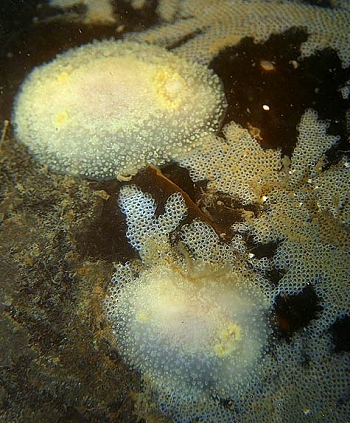
Note added 21 June 2007: See message #20054 suggesting this is Acanthodoris pilosa.
Dear Sven,
This animal is almost certainly a member of the Onchidorididae but they are difficult to distinguish from one another - especially for someone with little personla experience of these northern species. It looks like Adalaria sp A in Just & Edmunds book on Lemche's illustrations. It also reminds me of Akiodoris lutescens which Millen & Martynov (2005) have placed in a new Family Akiodorididae.
Hopefully one of our colleagues from northern waters will be able to help with an identification.
-
Just, H. & Edmunds, M. (1985) North Atlantic Nudibranchs (Mollusca) seen by Henning Lemche. With additional species from the Mediterranean and north east Pacific. Ophelia, Supplement 2: 1-149.
-
Millen, S. V. and Martynov, A. V. Redescriptions of the nudibranch genera Akiodoris Bergh, 1879 and Armodoris Minichev, 1972 (Suborder Doridacea), with a new species of Akiodoris and a new family Akiodorididae. Proceedings of the California Academy of Sciences 56[1], 1-22. 2005.
Best wishes,
Bill Rudman
Re: Acanthodoris pilosa? - color variation
April 30, 2003
From: Alan Shepard
Bill -
Dr. Larry Harris of the University of New Hampshire took a look at the photo I recently sent you that I tentatively identified as Acanthodoris pilosa. He concurred that it is indeed A. pilosa. Additionally he indicated that they feed upon bryozoans of the species Flustrellidra and Alcyonidium.
Best wishes,
Alan Shepard
Tolland, CT, USA
alan.chepard@snet.net
Thanks Alan,
I don't like leaving things on the 'unidentified pages' - they have a habit of never being seen again!
Best wishes,
Bill Rudman
Acanthodoris pilosa? - color variation
March 25, 2003
From: Alan Shepard
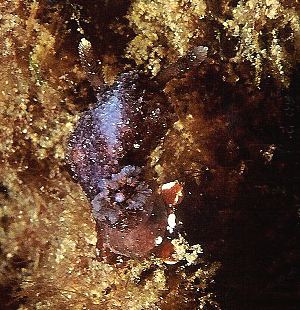
Bill -
I was rummaging through a few older photos and came across this one. I'm fairly sure this is Acanthodoris pilosa. Normally we find the white variety here in New England but that may be because they stand out better against their surroundings. From time to time I find cream colored individuals. One time I did however find this black version.
I photographed this one At Folly Cove in Gloucester, Massachusetts in approximately 5 meters of water about one year ago. It was small, no more than 15 to 20 millimeters long. Hadn't seen this color variation before and haven't seen it since.
Best wishes,
Alan Shepard
Tolland, CT
alan.chepard@snet.net
Shepard, A., 2003 (Mar 25) Acanthodoris pilosa? - color variation. [Message in] Sea Slug Forum. Australian Museum, Sydney. Available from http://www.seaslugforum.net/find/9410Dear Alan,
Sherman Bleakney discusses colour variation of Acanthodoris pilosa in north America in his interesting book. He has no answers but has some challenging suggestions for research projects. He observes that in the Bay of Fundy, Nova Scotia, Acanthodoris pilosa occurs in all colour varieties while in adjacent Minas Basin only mauve or white specimens were found.
However I wonder if this is not Acanthodoris? It is a bit difficult from this photo to see its real shape but it seems to have some of the features of Goniodoris castanea. If the two white spots behind the gills represent a break in the mantle then its hape would be quite Goniodoris-like. I am not sure it has been recorded from the western Atlantic, but there is no reason why it shouldn't be there. I would be grateful for comments from those familiar with this species
Best wishes,
Bill Rudman
Feeding in Acanthodoris pilosa
December 13, 2002
From: Derek
Dear Bill,
I was at this site and I am having some trouble finding how Acanthodoris pilosa eats. Right now I am a grade 10 high school student, and I am doing research on Acanthodoris for an Extra-curricular class: Marine Biology. I needed a whole bunch of information, but the only thing I can't seem to find is how it eats. If you gave me the information, I would be very grateful.
Thanks in Advance,
Derek
derek_the_great@emailaccount.com

Dear Derek,
Acanthodoris pilosa belongs to the family Onchidorididae, which mainly feed on bryozoans, or in one case, barnacles. What these food organisms all have in common is a hard external shell protecting the fleshy animal that the slugs want to eat. Acanthodoris feeds on Bryozoans which form a layer over hard surfaces. They are often called Lace Corals, because the colony consists of tiny calcareous cells, each one containing an individual animal. When dead the skeleton looks like a piece of fine lace work. Why I mention the nature of the bryozoan colony is because Acanthodoris when feeding, needs to be able to pick the individual animals out from their protective calcareous cells. Most dorid nudibranchs feed by scraping off parts of their food with their radular ribbon, which is a tongue-like structure, lined with many small teeth. In the onchidorids however, just scraping won't get their food out of its protective exoskeleton. So their radula is quite specialised with just two large teeth in each row which are used to pick out, or at least poke into the individual bryozoan cell. To help in getting the individuals out of each cell, onchidorids also have a unique buccal pump which acts like a little syringe, sucking the animal out of its protective case, after it is loosened by the radula.
To illustrate this feeding mechanism, I have made a quick sketch of the foregut of an onchidorid [with body wall removed]. The oral tube is a flexible tube which could be compared to a proboscis in some insects. It leads back to the buccal cavity in which the radula sits, and into which the large muscular buccal pump opens. During feeding, the radula is pushed forward to the mouth where it can pick around and loosen the bryozoan individuals. The buccal pump then sucks the food particles up into the buccal cavity and they are then moved back into the oesophagus, which leads to the stomach. If you don't understand any of this please let me know.
[If you us the SEARCH button at the top of each page to look for 'radula' you will find photos of many different types of radula. Unfortunately I haven't a good photo of the teeth of Acanthodoris. There is a very complete study, by Crampton, of the foregut of the similar Onchidoris bilamellata which I list below. For anyone wanting a complete description of the musculature and histology of the tissues its the place to go.
• Crampton, D.M. (1977) Functional anatomy of the buccal apparatus of Onchidoris bilamellata (Mollusca: Opisthobranchia). Transactions of the Zoological Society of London, 34: 45-86.
Good Luck with your project,
Bill Rudman
Re: Identity of Acanthodoris pilosa
December 13, 2002
From: Ron Velarde
Dear Bill/ Bernard,
I can not add anything to Bernard's message regarding Acanthodoris pilosa, but you should take a look at Sandra Millen's paper on Onchidoris muricata.
• Millen, S.V. 1985. The nudibranch genera Onchidoris and Diaphorodoris (Mollusca, Opisthobranchia) in the northeastern Pacific. The Veliger, 28(1): 80-93.
Good Luck.
Ron Velarde
rvelarde@sandiego.gov
Thanks Ron,
Bill Rudman
Information on Acanthodoris pilosa
December 12, 2002
From: Alma Sánchez
Dear Dr. Rudman,
I would need to know the reference of the original description of the species Acanthodoris pilosa (Müller, 1789).
Thank you very much
Alma
almasanchez83@hotmail.com
Sánchez, A., 2002 (Dec 12) Information on Acanthodoris pilosa. [Message in] Sea Slug Forum. Australian Museum, Sydney. Available from http://www.seaslugforum.net/find/7748Dear Alma,
See Bernard Picton's interesting reply
Bill Rudman
Identity of Acanthodoris pilosa
December 12, 2002
From: Bernard Picton
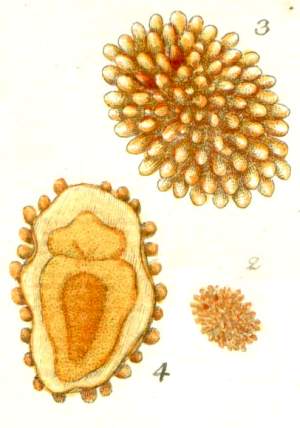
FIGURES: From Muller, 1788. Tab LXXXV.
Doris muricata. Figs 2-4.
Doris pilosa. Figs 5-8.
[individual images rearranged digitally].
Dear Bill & Alma,
I've ended up spending some time answering what I thought would be a simple question! I actually have a copy of this rather rare book in my office. The description of Doris pilosa is actually in part 3 which is bound with other parts but starts new page numbering. The citation should really be Abildgaard in Muller, 1789, not Muller. Doris pilosa is Page 7. In another volume, which has the plates, it is Plate (Tabula) LXXXV. I'm upset because I don't think this is what we call Acanthodoris pilosa today at all! Alder & Hancock accepted this name as they say other authors before them had, but they are clearly unhappy about it and would settle for the name Doris stellata Gmelin, 1783. I can't read Latin very well, the description is in Latin. The illustration seems to show something with no gills, like a Doridella or Corambe.
What is worse is that also on this same plate is Doris muricata and in my opinion this is what we now call Adalaria loveni. This change would also leave us looking at a name change for Onchidoris muricata. Doris aspera of Alder & Hancock is certainly what we now call Onchidoris muricata. I'm not good at this sort of thing - rules of nomenclature, etc. so I'll have to see if someone wants to take on the job of sorting out the confusion. Doris muricata is actually first described in Muller's prodromus of 1776, so this later description and illustration is not the original one.
Christine Morrow recently realised that one of Muller's sponge names was being used wrongly. These mistakes were mostly made by the Victorian naturalists over 100 years ago so it messes up the more recent literature correcting them. This case was made even more confusing by the fact that there was a specimen in the Copenhagen museum labelled as type, while the illustration looks like another common species.
• Abildgaard, Petrus Christianus. 1789. [In]: O. F. Muller. Zoologia Danica, etc., Vol. 39(3):1-71, pls. 81-120.
• Muller, O. F. 1788. Zoologia Danica sev animalium Daniae et Norvegiae rariorum ac minus notorum descriptiones et historia, Vol. 2: 124 pp., pls. 51-80.
• Morrow, C.C. & Boury-Esnault, N., 2000. Redescription of the type species of the genus Polymastia Bowerbank, 1864 (Porifera, Demospongiae, Hadromerida). Zoosystema, 22(2): 327-335
Bernard
bernard.picton.um@nics.gov.uk

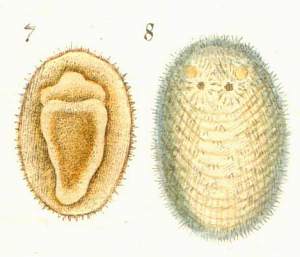
Thanks Bernard,
Many nomenclatural mistakes seem to be caused by not looking at the original literature so it is good to see some of the source material - though I must admit I like it better when it confirms our current ideas
Cheers,
Bill Rudman
Acanthodoris pilosa and egg ribbons
July 23, 2002
From: Bernard Picton
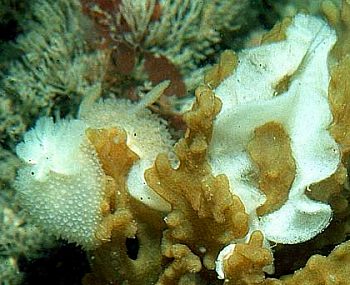

Hi Bill,
Here a picture of Acanthodoris pilosa showing two adults and their spawn coils on the fleshy bryozoan Alcyonidium diaphanum which is a common food of this nudibranch. This photo also shows two Goniodoris nodosa juveniles, I've enlarged the one to bottom right.
Lundy Island, Bristol Channel. - July 1976
Bernard
bernard.picton.um@nics.gov.uk
Picton, B. , 2002 (Jul 23) Acanthodoris pilosa and egg ribbons. [Message in] Sea Slug Forum. Australian Museum, Sydney. Available from http://www.seaslugforum.net/find/7611Thanks Bernard,
Bill Rudman
Acanthodoris pilosa from Ireland
July 22, 2002
From: Bernard Picton
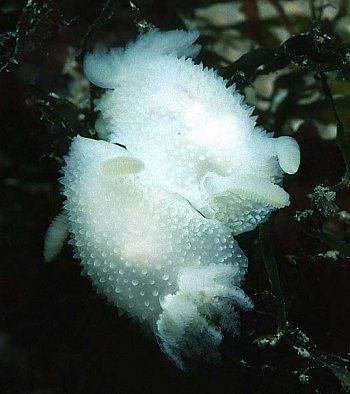
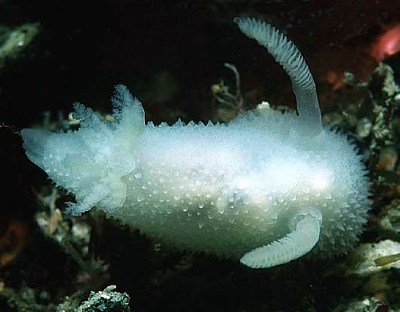
Hi Bill,
As I promised, here are some pictures of Acanthodoris pilosa from the Aran Islands, W. Ireland - Sept 2001.
Bernard
bernard.picton.um@nics.gov.uk
Picton, B. , 2002 (Jul 22) Acanthodoris pilosa from Ireland. [Message in] Sea Slug Forum. Australian Museum, Sydney. Available from http://www.seaslugforum.net/find/7610Thanks Bernard,
Can I assume that the brown animals from the Netherlands are a colour variant of this species?
Bill Rudman
Re: Adalaria proxima? from Massachusetts
July 12, 2002
From: Bernard Picton
Hi Bill,
I'm fairly sure that Andrew's slug is not Adalaria, nor Onchidoris but Acanthodoris pilosa. I'll send a couple of Acanthodoris pilosa pictures in a separate email.
Bernard
bernard.picton.um@nics.gov.uk
Picton, B.E., 2002 (Jul 12) Re: Adalaria proxima? from Massachusetts. [Message in] Sea Slug Forum. Australian Museum, Sydney. Available from http://www.seaslugforum.net/find/7531Dear Bernard,
Thanks for the identification, I see now the papillae in Andrew's photos don't narrow at the base as occurs in Adalaria proxima and Onchidoris muricata. Thanks also for the photos which I will post in the next few days.
Cheers,
Bill Rudman
Re: Adalaria proxima? from Massachusetts
July 12, 2002
From: Irina Roginskaya
Dear.Andrew,
Your mollusc reminds me of Acanthodoris pilosa Abildgaard in Mueller,1789, -soft small conical tubercles, characteristic prominences on the border of rhinophorial sheaths. The White Sea specimens of A. pilosa that I have observed feed exclusively on the encrusting bryozoan Flustrella hispida Fabricius, abundant on the 'leaves' of the intertidal brown alga Ascophyllum nodosum L.
Irina Roginskaya.
irina7@hotmail.com
Roginskaya, I., 2002 (Jul 12) Re: Adalaria proxima? from Massachusetts. [Message in] Sea Slug Forum. Australian Museum, Sydney. Available from http://www.seaslugforum.net/find/7532Thanks Irina,
Bill Rudman
Adalaria proxima? from Massachusetts
July 11, 2002
From: Andrew Martinez
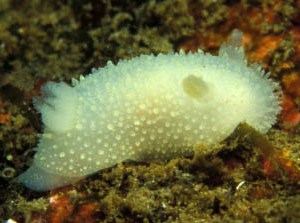

Dear Bill,
Would you please tell me if this nudibranch is Adalaria proxima. My other choice is Onchidoris muricata. I am fairly sure it is Adalaria but I have never seen one before this day. I photographed this on Jan 26, 2002, in 25 feet (8 meters) close to shore on rocks. In Cape Ann, Massachusetts United States
Attached are two views of the same animal.
Thanking you in advance,
Andrew Martinez
amart@mediaone.net
Martinez, A., 2002 (Jul 11) Adalaria proxima? from Massachusetts. [Message in] Sea Slug Forum. Australian Museum, Sydney. Available from http://www.seaslugforum.net/find/6230Dear Andrew,
I agree that these are the two most likely possibilities, but since ecologists who work with large numbers of these two species in Europe, have great difficulty separating them from one another externally, I am very hesitant to jump in with anything definitive. I think the fairly pointed papillae we can see in your photos is characteristic of Adalaria proxima. Perhaps one of our European colleagues will be more confident.
Best wishes,
Bill Rudman
Acanthodoris pilosa from British Columbia
May 29, 2002
From: Marli Wakeling
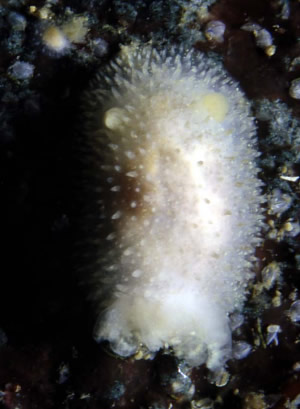
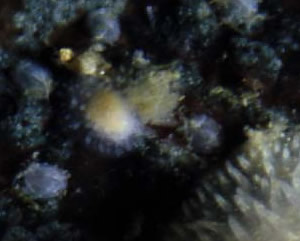
Hi Bill,
Here is Acanthodoris pilosa from Keats Island in Howe Sound near Vancouver, British Columbia. There seems to be a tiny juvenile to the upper right of the animal.
Dive Site: Eastbourne Wall, Keats Island, British Columbia
Depth: 50 feet
Length: 1 cm.
Date: April 21,2002
Photo by: Marli Wakeling
Marli
scubamarli@excite.com
Wakeling, M., 2002 (May 29) Acanthodoris pilosa from British Columbia. [Message in] Sea Slug Forum. Australian Museum, Sydney. Available from http://www.seaslugforum.net/find/6891Thanks Marli,
Bill Rudman
Re: Adalaria? from British Colombia
March 18, 2001
From: Jeff Goddard
Hi Bill,
Regarding Marli Wakeling's onchidoridid from British Columbia: the shape of the body (significantly wider anteriorly), the long posteriorly curving rhinophores, and smooth conical dorsal papillae all point to an Acanthodoris. The only completely white Acanthodoris in the northeastern Pacific is A. pilosa. The branchial plumes in Marli's specimen look small for an Acanthodoris, especially A. pilosa, but they may have been partially contracted. Also, it would be useful to know the size of her specimen, as species of Acanthodoris grow much larger than other onchidoridids. Species of Acanthodoris also have few (if any?) spicules in their dorsal papillae, which makes them much softer to the touch than species of Onchidoris and Adalaria.
Best wishes,
Jeff
Thanks Jeff,
Bill Rudman
Re: Adalaria? from British Columbia
March 18, 2001
From: Alexander Martynov
Dear Marli,
The external feautures of your animal suggest that it should be species of genus Acanthodoris
All the best,
Alexander
martyn@AM3963.spb.edu
Martynov, A., 2001 (Mar 18) Re: Adalaria? from British Columbia. [Message in] Sea Slug Forum. Australian Museum, Sydney. Available from http://www.seaslugforum.net/find/4004Thanks Alexander,
With your comment and Jeff Goddard's message I feel pretty safe in identifying it as Acanthodoris pilosa
Bill Rudman.
Adalaria? from British Columbia
March 15, 2001
From: Marli Wakeling

Here is another Adalaria type animal from Howe Sound in British Columbia. I'm not able to identify it from any guide books that I have. Perhaps someone out there can identify it.
Marli.
scubamarli@excite.com
Wakeling, M., 2001 (Mar 15) Adalaria? from British Columbia. [Message in] Sea Slug Forum. Australian Museum, Sydney. Available from http://www.seaslugforum.net/find/3824Dear Marli,
Following the excellent response to your Diaphorodoris lirulatocauda photo, I am sure we will get an answer for this nice photo.
Best wishes,
Bill Rudman
Acanthodoris pilosa for the layman
December 31, 2000
From: John Pancharian
Though I am not a biologist, professional or otherwise, I have recently taken an interest in Acanthodoris pilosa. I would appreciate it if someone would be good enough to point me to sources of information accessible (as nearly as possible) to the layman. I am interested mostly in A. pilosa native to Central California.
Thank you so much for the help.
John Pancharian
john@wpi.com
Pancharian, J., 2000 (Dec 31) Acanthodoris pilosa for the layman. [Message in] Sea Slug Forum. Australian Museum, Sydney. Available from http://www.seaslugforum.net/find/3298Dear John,
California is a hotbed of opisthobranch enthusiasts so I am sure that someone will respond either directly, or through the Forum, to your request. If you have any observations or photos you would be willing to share they would be very welcome on the Forum.
Best wishes,
Bill Rudman
Acanthodoris pilosa from Holland
August 25, 1999
From: Peter H. van Bragt


Dear Bill,
Here is a photo of Acanthodoris pilosa to add to the Netherlands' List.
Location: : Zierikzee (Zeelandbrug), de Oosterschelde, the Netherlands
With best regards
Peter H. van Bragt
Peter.vanBragt@ftn.hsbrabant.nl
van Bragt, P.H., 1999 (Aug 25) Acanthodoris pilosa from Holland. [Message in] Sea Slug Forum. Australian Museum, Sydney. Available from http://www.seaslugforum.net/find/1230Thanks Peter,
Am I right in assuming the egg mass in the lower photo does not belong to Acanthodoris?
Bill Rudman.
